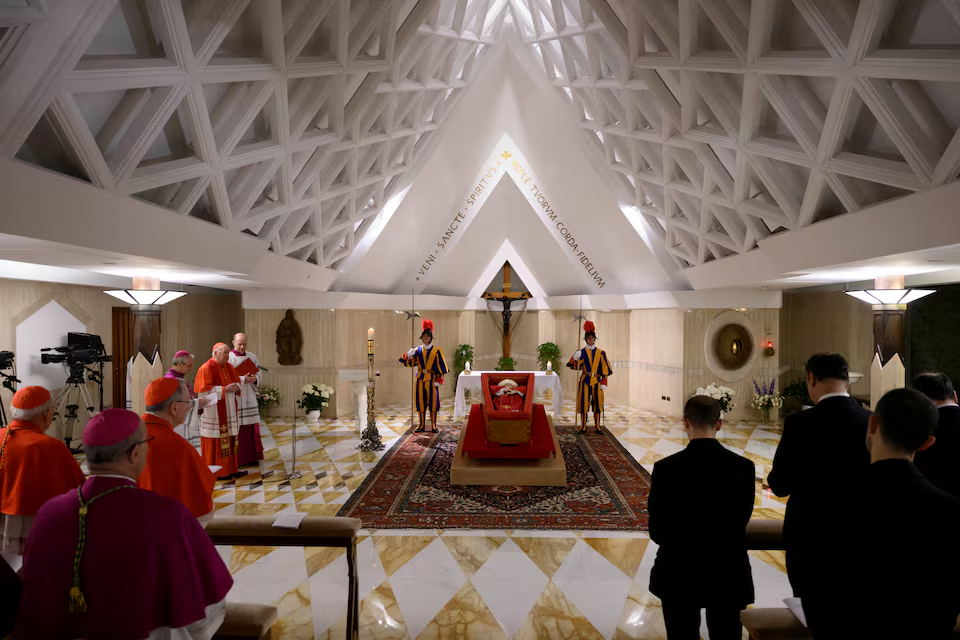The body of Pope Francis is placed in an open casket during the rite of the declaration of death in Santa Marta residence at the Vatican, April 21, 2025
Vatican City, April 22 — Pope Francis‘ funeral will be held on Saturday in St. Peter’s Square, Roman Catholic cardinals decided on Tuesday, setting the stage for a solemn ceremony that will draw leaders from around the world.
Pope Francis, 88, died on Monday after suffering a stroke and cardiac arrest, ending an often turbulent reign in which he repeatedly clashed with traditionalists and championed the poor and marginalised.
The pontiff spent five weeks in hospital earlier this year suffering from double pneumonia and had appeared to be slowly recovering, but the Vatican on Tuesday recounted his last moments, saying death came quickly and he had not suffered.
He started to feel unwell at around 5:30 a.m. (0330 GMT) on Monday and was promptly attended to by his team. More than an hour later he made a gesture of farewell to his ever-present nurse, Massimiliano Strappetti, and slipped into a coma, the Vatican’s official media channel said.
His time of death was given as 7:35 a.m.
The Vatican released photographs of Francis dressed in his vestments and laid in a wooden coffin in the chapel of the Santa Marta residence, where he lived during his 12-year papacy. Swiss Guards stand on either side of the casket.
His body will be taken into the adjacent St. Peter’s Basilica on Wednesday morning at 9:00 a.m. (0700 GMT), in a procession led by cardinals, allowing the faithful to pay their last respects to the first Latin American pope.
His funeral service will be held in St. Peter’s Square, in the shadow of the Basilica, on Saturday at 10:00 a.m. and will be presided over by Cardinal Giovanni Battista Re, the 91-year-old dean of the College of Cardinals.
U.S. President Donald Trump, who clashed repeatedly with the pope about immigration, said he and his wife would fly to Rome for the service.
Among other heads of state set to attend were Javier Milei, president of Francis’ native Argentina, Brazilian President Luiz Inacio Lula da Silva and Ukrainian President Volodymyr Zelenskiy, according to a source in his office.
In a break from tradition, Francis confirmed in his final testament released on Monday that he wished to be buried in Rome’s Basilica of Saint Mary Major and not St. Peter’s, where many of his predecessors were laid to rest.
Francis’ death has set in motion ancient rituals, as the 1.4-billion-member Church started the transition from one pope to another, including the breaking of the pope’s “Fisherman’s Ring” and lead seal, used in his lifetime to seal documents, so they cannot be used by anyone else.
As Catholics worldwide mourned Francis, all cardinals in Rome were summoned to a meeting on Tuesday to decide on the sequencing of events in the coming days and review the day-to-day running of the Church in the period before a new pope is elected.
A conclave to choose a new pope normally takes place 15 to 20 days after the death of a pontiff, meaning it should not start before May 6. The exact date will be decided by cardinals after Francis’ funeral.
Some 135 cardinals are eligible to participate in the secretive ballot, which can stretch over days before white smoke pouring from the chimney of the Sistine Chapel tells the world that a new pope has been picked.
At present there is no clear frontrunner to succeed Francis.
Pope Francis inherited a Church in disarray and worked hard to overhaul the Vatican’s central administration, root out corruption and, after a slow start, confront the scourge of child abuse within the ranks of the priesthood.
He often clashed with conservatives, nostalgic for a traditional past, who saw the pope as overly liberal and too accommodating to minority groups, such as the LGBTQ community.
Francis appointed nearly 80% of the cardinal electors who will choose the next pope, increasing, but not guaranteeing, the possibility that his successor will continue his progressive policies.
One of the hallmarks of Francis’ reign was his decision to appoint cardinals to far-flung regions – places where Roman Catholics make up a tiny minority or where the Church is growing faster than in the mostly stagnant West.
While Europe still has the largest share of cardinal electors, with about 39%, it is down from 52% in 2013, when Francis became pope. The second largest group of electors is from Asia and Oceania, with about 20%.
Many of the cardinals are little known outside their own countries and they will have a chance to get to know one another at meetings known as General Congregations that take place in the days before a conclave starts and where a profile of the qualities needed for the next pope will take shape.
Additional reporting by Alvise Armellini and Giulia Segreti; Writing by Crispian Balmer; Editing by Cynthia Osterman and Alex Richardson



